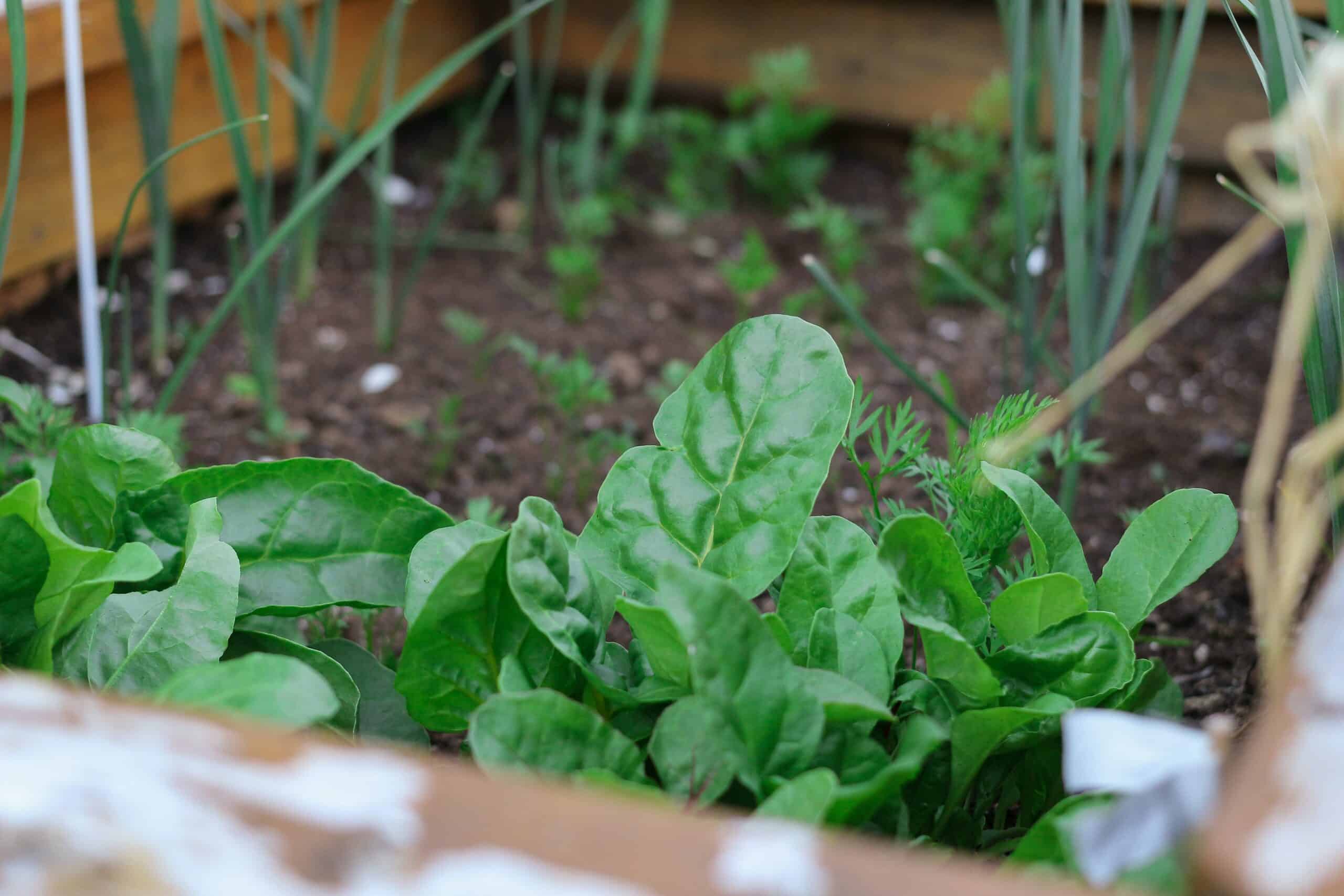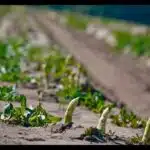Do you want to grow the tastiest spinach ever? Of course you do – who wouldn’t?! Growing delicious spinach is easier than you think, and with a few simple steps, you can be harvesting your own succulent leaves in no time. Prepare for the most mouth-watering produce you’ve ever tasted – it will be like eating spinach from the gardens of heaven!
Spinach is a wonderful vegetable to grow in your garden, not just because it’s packed with vitamins and minerals but also because it’s relatively easy to cultivate. With just a bit of knowledge and some effort, you can have an abundance of fresh greens available for all your culinary needs. Plus, growing your own spinach gives you peace of mind knowing that it’s organic and free from chemicals or additives.
So what do you need to know about growing the best tasting spinach? Read on to find out how to get started planting your own harvest of tasty greens! With our tips and tricks, we guarantee that this will be the tastiest batch of spinach you’ve ever had!
Choosing The Right Spinach Variety
Growing the tastiest spinach ever is a dream come true! With the right variety, soil preparation, and planting conditions, your spinach will reach new heights of deliciousness. Here’s how to get started.
Choosing the right spinach variety is key to growing sensational spinach. Spinach comes in two types: savoyed and semi-savoyed; the former has curly leaves, while the latter has flat smooth ones. Both are packed with nutrients and taste great, so it’s up to you which one you’d prefer. Additionally, make sure to select a hardy variety that does well in your area’s climate – this will ensure more reliable harvests.
No matter what type you choose, taking care when preparing the soil is essential for growing delicious spinach. Make sure to remove any weeds from the space before planting, as well as test pH levels by getting a soil sample tested at a local university or extension office. Additionally, enriching your soil with compost or manure will add vital nutrients for your plants’ growth. And when it comes time to plant…
Preparing The Soil
Growing spinach is like baking a cake; the ingredients need to be just right for the best results. Preparing the soil is an essential part of this process, and requires some specific steps.
First and foremost, you’ll want to ensure your soil has high fertility. This will provide the spinach with enough nutrients to grow. To do this, it’s important to add organic material such as compost or manure into your soil before planting. You’ll also want to make sure that your soil is well-drained and not too acidic or alkaline by testing its pH levels regularly.
Once you have your soil in optimal condition, you can prep the area for planting by weeding out any unwanted plants and tilling the soil with a rake or hoe to loosen it up. Be sure to turn over clumps of dirt so that the spinach has plenty of space and room to grow!
By taking these steps and creating a healthy environment for your spinach, you’re setting yourself up for success in growing some of the tastiest spinach ever!
Planting Spinach
Once the soil is prepped, it is time to plant the spinach. First, choose a sunny spot in the garden and spread a thin layer of compost over the soil. This will give the spinach plants extra nutrients as they grow.
Spinach seeds should be planted about an inch deep and two inches apart in rows or circles. It is important to keep them evenly spaced so they can get enough sunlight and air circulation. After sowing, lightly water the area with a hose or watering can and wait for them to start germinating in a few days.
When planting spinach, it is important to remember that some varieties take longer than others to mature. Be sure to check the seed packet for specific details on when to harvest your crop. Moving forward, consistent watering of your spinach plants is essential for growing delicious greens that are full of flavor.
Watering Spinach
Once you’ve planted spinach, it’s important to make sure you keep it watered. Spinach prefers moist soil, so aim for about 1-2 inches of water per week. You can check the soil moisture with a soil thermometer — if the top few inches are dry, it’s time to water your spinach.
It’s best to water your spinach in the morning or evening so the leaves don’t stay wet all day. This will help reduce the chances of disease and fungal growth on your plants. If you notice any signs of wilting or yellowing leaves, this is a sign that your spinach needs more water.
You also want to be careful not to over-water your spinach as this can cause root rot and other issues. Too much water can drown out the oxygen that the roots need to absorb nutrients from the soil and thrive. If you notice signs of root rot such as yellowing and wilting leaves, decrease watering frequency until you get back on track. With proper watering techniques, your spinach will be thriving in no time!
Fertilizing Spinach
Fertilizing spinach is like turbocharging a rocket ship, propelling it forward faster and higher than without the extra fuel. It’s essential to ensure maximum growth, health and flavor of this delicious leafy green.
The best way to fertilize spinach is by using a slow-release fertilizer. This type breaks down over time and provides a steady stream of nutrients for the plant throughout its growing season. Apply the fertilizer in an even layer around the base of each plant and keep it away from their stems or leaves so that it won’t burn them. Additionally, adding some compost can also help add nutrients to the soil as well as improve drainage and aeration.
It’s also important to remember that excess fertilizer can cause harmful runoff into nearby streams or ponds, so be sure to check with your local authorities about any regulations regarding fertilizer use in your area before getting started. With these simple steps, you’ll be on the path towards growing some of the tastiest spinach ever!
Weed Control
Weeding a garden is like cleaning house. It’s a chore, but it’s necessary if you want to give your spinach the best chance of success. Weed control is an important step in growing the tastiest spinach ever.
Weeds are relentless invaders that can compete with your spinach for resources such as nutrients, water, and light. Left unchecked, they can quickly spread and choke out the spinach plants. To keep weeds from taking over, carefully pull them out by their roots or use an organic herbicide when necessary.
Check for weeds regularly so that your spinach has plenty of room to grow and thrive. Taking the time for this extra step will ensure that your hard work pays off in a delicious harvest!
Rotating Spinach Plantings
Have you ever wondered how to grow the tastiest spinach ever? Rotating spinach plantings is a key component for growing delicious and nutritious spinach. By rotating your spinach plantings, you can reduce the risk of soil-borne diseases, pests, and weeds. Let’s look at how to rotate your spinach plantings to get the tastiest harvest.
When it comes to rotating your spinach planting, it’s best to follow a three-year rotation cycle. That means every year, you should move the bed or container where you planted last year to a different spot in the garden. This will help keep pests from lingering in one spot and also prevent nutrient depletion from overfertilizing or overwatering one area.
It’s also important to mix up the types of plants you’re growing in each space. If possible, try alternating between leafy greens like spinach and root vegetables such as carrots or beets. This will help ensure that each bed has different nutrients and pest pressures so that it stays healthy and productive for years to come.
By following these steps, you can help promote vigorous growth and a nutritious harvest while keeping disease and pests away from your precious spinach plants! The next step is mulching, which helps protect your plants from temperature fluctuations and moisture loss during extreme weather conditions.
Mulching
Mulching can be a great way to protect your spinach plants from weeds and help them retain moisture. It’s also beneficial for keeping the soil temperature steady, which helps the spinach grow faster and better. When mulching, use organic materials such as grass clippings, composted leaves, or straw. This will provide nutrition to the plant while helping it stay healthy.
Be sure to spread the mulch around the spinach in a thick layer, but keep it away from the stem and base of the plant. Once you’ve covered the area with mulch, water it regularly so that it stays moist and provides protection from heat and cold weather. You should also make sure that there is enough air circulation for the spinach by occasionally turning over the mulch or stirring it up with a rake or shovel.
By following these steps, you’ll be able to give your spinach plants a better chance at thriving in any climate or season. Mulching helps keep weeds away, retains moisture in the soil, and provides extra nutrition for your plants — all of which are essential for growing delicious spinach! Now that we’ve discussed how to mulch your spinach effectively, let’s look at how to protect it from pests and diseases.
Protecting Spinach From Pests And Diseases
Ah, spinach. Who hasn’t wished to grow the tastiest spinach ever? I’m sure we’ve all had a dream of succulent little leaves that make our taste buds tingle with delight. But before you can get to the delicious part, there’s one more step – protecting spinach from pests and diseases. Sounds like a drag, right? Wrong!
Turns out, it’s actually quite simple. Make sure your soil has good drainage and plenty of organic matter in it, water regularly and weed often. You can also use an insecticidal soap or spray for any pests you find munching on your greens. Additionally, if you’re worried about diseases like root rot or mildew, try using a fungicide spray at least twice during the growing season.
By following these steps you’ll be well on your way to enjoying those tasty little leaves that dreams are made of – without having to worry about pesky bugs or disease ruining them! So don’t wait another second to start your journey towards great-tasting spinach – thinning it will be the next step you take!
Thinning Spinach
Thinning spinach is a crucial step in ensuring the health of your crop. According to the National Gardening Association, 90% of gardeners thin their vegetable plants correctly. This is great news for home spinach growers! Thinning helps to promote healthy growth by allowing individual plants to have more access to nutrients and sunlight.
When thinning your spinach, you should leave an inch between seedlings. This will give them room to grow without overcrowding one another and competing for resources. It’s best to thin when the seedlings are still small, so that you don’t disturb any mature roots. You can also use scissors or shears instead of fingers if it makes the job easier.
You want to ensure that each plant has enough space and resources for optimal growth, so be sure not to leave too much or too little space between each seedling. When done correctly, thinning can help you create a bountiful harvest of delicious spinach! With this knowledge in hand, you’re ready to move on to harvesting your spinach crop.
Harvesting Spinach
Harvesting spinach is like reaping the rewards of your hard work. A gardener’s efforts come to fruition when they finally get to pick the delicious and nutritious leaves of spinach. Knowing when and how to harvest spinach is key to ensure it tastes its best.
When harvesting spinach, start by looking for full-sized leaves that are a deep green color. Then, use scissors or your hands to pick the leaves off the plant at the stem near their base – this will help encourage further growth in the plant. Avoid picking any yellowed or wilted leaves, as they won’t taste as good as fresh ones.
It’s important not to over-pick your plants either; if you take too many leaves from each one, you can stunt its growth and reduce future harvests. The best thing about growing spinach is that it can be harvested multiple times throughout the season if picked correctly. This means you can enjoy a constant supply of this nutrient-packed veggie right through until winter!
By harvesting carefully, you’ll be able to keep your spinach healthy and tasty for months on end – so don’t forget these tips next time you’re gathering up your greens!
Keeping Spinach At Its Best
Harvesting spinach is one thing, but keeping it at its best is a whole other game. While the tips and tricks to growing the tastiest spinach are important, they don’t mean much if you don’t know how to keep it fresh and flavorful after picking. Learning how to properly store spinach will ensure its deliciousness for longer.
First off, it’s essential to get rid of any excess moisture on the leaves before storing the plant. The best way to do this is by gently patting them down with a paper towel or kitchen cloth. Once your spinach is dried off, you’ll want to make sure you’re not exposing it to too much light or air – both of which can strip away flavor and nutrients from the leaves. To prevent this, wrap your spinach in aluminum foil or place it in an airtight container before putting it in the fridge.
By taking these steps, you’ll be able to keep your spinach at its peak for weeks. But don’t let that stop you from using up all of your delicious greens – there are plenty of ways to incorporate them into your cooking!
Using Spinach In The Kitchen
Little did we know that the spinach we were growing in our garden would lead us to discovering an entirely new way of using it in the kitchen. Our journey has taken us through proper maintenance and care, now onto what’s next!
Using spinach in the kitchen is all about unlocking its potential, and knowing how to cook it so that its flavor can really shine through. With some simple techniques, you can make sure that your spinach dish will be as delicious as possible.
For starters, try blanching spinach for a few seconds before adding it to a stir-fry or sautéing it with garlic and olive oil. This will help bring out its natural sweetness and add texture. Don’t forget to season your finished dish with salt and pepper too! By following these steps, you’ll be able to enjoy flavorful, crunchy spinach in all of your meals.
Now that we’ve mastered using spinach in the kitchen, let’s move on to the next step – composting!
Composting Spinach
We’ve been on quite the jaunty journey, one of spinach-growing excellence. Composting this bountiful vegetable is the final step in ensuring that you get the tastiest spinach possible.
Composting is a great way to add essential nutrients back into the soil for your plants to utilize, and it’s also an environmentally friendly way to dispose of your kitchen scraps. Spinach leaves, stems and roots can all be composted, so there’s no need to throw them away! Simply put them in a compost pile or bin and they’ll decompose over time. You can also use a tumbler composter if you don’t want to wait too long for your compost to be ready to use.
It’s important not to mix any diseased plants with your compost as this could spread disease throughout your garden. The best way to do this is by picking out any damaged or diseased spinach leaves before adding them to the compost pile or bin. Once you’ve done this, you should have plenty of nutrient-rich compost ready to nourish your spinach crop! With that in mind, let’s move on to troubleshooting common spinach problems.
Troubleshooting Common Spinach Problems
Planting spinach can be a rewarding experience, but it does come with its challenges. It’s like an obstacle course; you have to prepare the soil correctly, provide enough water and sunlight, and keep an eye out for pests. Troubleshooting common spinach problems is often the biggest hurdle of all.
Growing spinach can be tricky – like threading a needle in the dark. There are plenty of issues that may arise such as disease, nutrient deficiency or too much heat or cold. The most common signs of trouble are wilting leaves and discoloration. To help solve these problems, it’s important to practice good hygiene in your garden by removing dead foliage and using mulch to prevent weed growth and soil moisture loss. Additionally, make sure the soil is well-drained so roots don’t rot and add fertilizer to ensure sufficient nutrients are delivered to the plant.
Many times, simply being aware of potential issues can go a long way towards avoiding them altogether. Taking preventive steps like checking for diseases or pests early on can help save time and energy in the long run. With some patience and dedication, you’ll soon be enjoying big batches of fresh spinach from your garden!
Frequently Asked Questions
How Long Does It Take For Spinach To Grow?
Growing spinach can be a great source of nutrition and heath benefits, but it’s important to know how long it takes for the plant to reach its full potential. You may be wondering why you should bother waiting if there are quicker alternatives out there. But with the right care and attention, fresh spinach from your own garden is worth the wait!
Spinach typically takes between 40–50 days to grow, depending on the variety and climate. There are some varieties that take up to 70 days to fully mature, so keep this in mind when deciding which type of spinach you want to grow. To speed up the process, sow several batches at different times throughout the season. This way, you can enjoy freshly harvested spinach all season long!
When it comes to growing healthy and tasty spinach, patience is key. With regular watering and adequate sunlight, your plants will thrive and provide delicious produce in no time. Plus, by taking a few simple steps like mulching and providing adequate drainage, you can ensure your spinach crop grows quickly without compromising its quality or taste. So don’t let impatience get in the way of growing your own delicious homegrown spinach—it’s well worth the wait!
Is Spinach A Cool Or Warm Season Crop?
An old adage says that good things come to those who wait. And it’s true; patience is key when growing the tastiest spinach ever. But, before you get started, you have to know whether spinach is a cool or warm season crop.
Spinach is actually a cool-season crop, meaning it can be planted anytime from late winter to early summer. Warmer temperatures can cause the leaves to become tough and bitter, so if you’re looking for the best flavor possible, it’s important to pay attention to your local climate and choose planting times that will ensure cooler temperatures throughout most of the growth cycle.
The good news is that spinach grows quickly – just 30 days from seed to harvest – so even with its cool-season requirement, you can still enjoy a delicious harvest in no time at all! With some planning and patience, you’ll soon have enough spinach for salads, soups and other tasty dishes.
How Often Should Spinach Be Watered?
The sweet smell of freshly-grown spinach wafts in the air, making us mouth-water with anticipation. It’s like a promise of deliciousness, a glimpse into the culinary world if you will. But how can we ensure that our spinach is not only tasty but also healthy? One key factor is watering – just how often should spinach be watered if we want to grow the tastiest ever?
When it comes to watering, spinach needs regular attention and a consistent schedule. Once planted, the soil should be kept moist but not soggy; a light sprinkle at least twice a week is usually enough. If you’re growing in containers or planters, check them every day and water as necessary. For best results, water earlier in the day so that any excess moisture has time to evaporate before nightfall.
Finally, don’t forget to fertilize your spinach periodically – once every month or two should do the trick! Use an all-purpose fertilizer diluted with water according to package instructions and apply it directly to the base of the plant. In addition, try adding some compost or other organic materials around the plants for added nutrients and beneficial microorganisms. With these simple tips in mind, you’ll soon be enjoying some truly delicious homegrown spinach!
How Do I Know When My Spinach Is Ready To Harvest?
Harvesting spinach at the right time is essential in order to get the tastiest results. To know when your spinach is ready to harvest, there are several things to look out for. Firstly, check the colour of your spinach leaves. When they start to turn a dark green colour, it’s a sign that it’s ready for harvesting. Secondly, take a look at the size of the leaves. If they are larger than three inches in diameter, then it’s probably time to harvest them. Finally, if you want to confirm that your spinach is ready for harvesting, you can test its texture by pinching or squeezing it gently with your fingers. If it’s firm and crisp, then you know it’s ready!
When harvesting your spinach, make sure that you don’t pull up the entire plant just yet – leave some of the smaller leaves on so that they can continue growing and provide more harvests in future weeks. It’s also important not to let spinach sit around after picking as this can cause it to become bitter and lose its flavour quickly. Instead, transfer your harvested spinach into containers as soon as possible and keep them in a cool place until you’re ready to eat or cook with them.
Harvesting spinach at exactly the right time will ensure that you get optimal taste from your crop – so be sure to pay attention to these key indicators when deciding when it’s ready! With these tips in mind, you should have no trouble growing delicious and flavourful spinach every time.
What Other Vegetables Can Be Grown Alongside Spinach?
Knowing what other vegetables to plant alongside spinach is an important part of the gardening process. Growing various types of plants together can improve growth, soil health and pest control – not to mention make for a beautiful garden! So, what other veggies should you consider when planting spinach?
The great thing about growing spinach is that it pairs well with many different vegetables. One popular option is to pair spinach with lettuces, as both require similar conditions. Peas are also a great companion for spinach since they have similar nutrient requirements and can provide nitrogen to the soil. Other veggies like tomatoes, peppers and carrots can also make good companions for your spinach crop.
When deciding which vegetables to grow in your garden, it is important to think about how they will interact with each other. Planting crops that are compatible will help ensure that your garden thrives and produces delicious vegetables. With careful planning and research into which vegetables will work best with your spinach crop, you’ll be able to create the perfect garden for harvesting tasty veggies!
Conclusion
Conclusion: Harvesting your own spinach is a rewarding experience! Not only do you get to enjoy the delicious results of your hard work, but you also gain knowledge and skills that will help you in future gardening endeavors. With a few simple tips, you can produce some of the tastiest spinach ever!
When it comes to growing spinach, timing is everything. Knowing when to plant, when to water, and when to harvest are essential for success. Spinach is a cool season crop that needs frequent watering and harvesting at the right time for optimal flavor. Growing other vegetables alongside spinach is also beneficial for maximizing yields and creating a more diverse vegetable garden.
By following these steps, you can ensure great success with your spinach crop! With proper planning and care, you’ll be able to harvest some of the freshest and tastiest spinach ever! So why not give it a try? You’re sure to be delighted with the results!





























